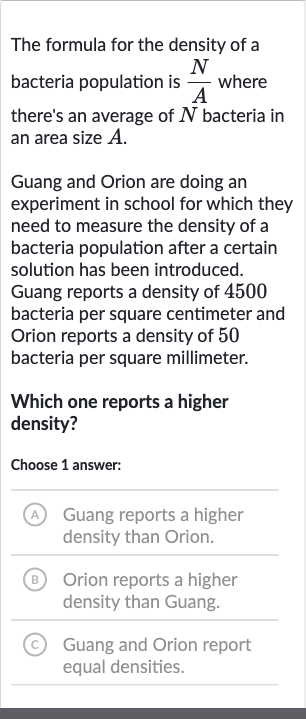AI tutor
Welcome to Bytelearn!
Let’s check out your problem:

The formula for the density of a bacteria population is where there's an average of bacteria in an area size .Guang and Orion are doing an experiment in school for which they need to measure the density of a bacteria population after a certain solution has been introduced. Guang reports a density of bacteria per square centimeter and Orion reports a density of bacteria per square millimeter.Which one reports a higher density?Choose answer:(A) Guang reports a higher density than Orion.(B) Orion reports a higher density than Guang.(C) Guang and Orion report equal densities.
Full solution
Q. The formula for the density of a bacteria population is where there's an average of bacteria in an area size .Guang and Orion are doing an experiment in school for which they need to measure the density of a bacteria population after a certain solution has been introduced. Guang reports a density of bacteria per square centimeter and Orion reports a density of bacteria per square millimeter.Which one reports a higher density?Choose answer:(A) Guang reports a higher density than Orion.(B) Orion reports a higher density than Guang.(C) Guang and Orion report equal densities.
- Convert Orion's density: To compare the densities reported by Guang and Orion, we need to ensure that they are expressed in the same units. Guang's density is given in bacteria per square centimeter, while Orion's density is given in bacteria per square millimeter.
- Calculate Orion's density: First, we convert Orion's density to bacteria per square centimeter. There are millimeters in a centimeter, so there are square millimeters in a square centimeter.
- Compare the densities: Orion's reported density is bacteria per square millimeter. To find the density per square centimeter, we multiply by (since there are square millimeters in a square centimeter).Orion's density in bacteria per square centimeter = .
- Conclusion: Now we compare the densities:Guang's density = bacteria/.Orion's density = bacteria/.
- Conclusion: Now we compare the densities:Guang's density = .Orion's density = .Since Orion's density () is greater than Guang's density (), Orion reports a higher density than Guang.
More problems from Power rule with rational exponents
QuestionGet tutor help
QuestionGet tutor help
QuestionGet tutor help
QuestionGet tutor help
QuestionGet tutor help
